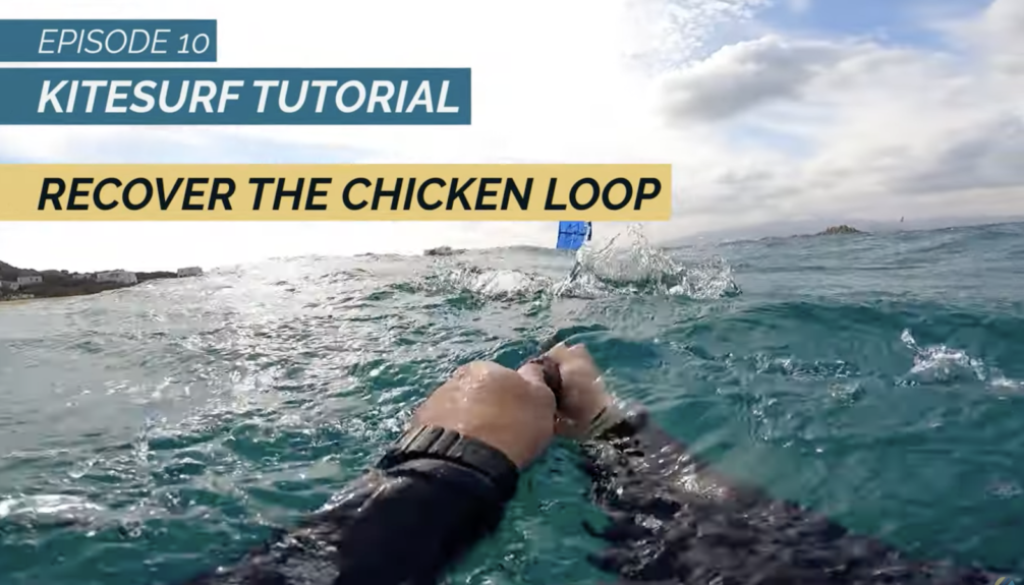RECOVER THE CHICKEN LOOP
Once you disconnect the chicken loop from your harness is it really necessary to end your session?
My name is Petar Pavlovic. I love sharing my Kitesurf Experience with you! In this episode we will see:
- The reason of disconnecting the chicken loop from your harness.
- How to safely recover the chicken loop.
- Analyze all the steps.
First we will see how your chicken loop can slide away unintentionally. As well as situations where you would eject your chicken loop quick release but immediately restart your session and ride.
Reasons for disconnecting the chicken loop
While launching the kite with an assistant some kiters love to be fully connected. They are also pulling the bar even before their lines have any tension. In this kind of situations it can often happen that the chicken loop slides out of place. As a result, it remains just on the edge of the hook or on the chicken stick.
This can also happen after a crash. The lines looses the tension and the kiter is still pulling aggressively on the bar.
Once you generated more power in the kite the chicken loop completely slides out.
And you could eject your chicken loop quick release for many other reasons.
Maybe you twisted with someone and disconnected but you managed to untangle the lines and you want to restart your session.
Some lines are twisted around your bar or your kite and it is generating power.
I often eject my chicken loop if after doing some tricks my kite looses the tension and starts falling in the power zone.
how to safely recover your chicken loop
- Pull on the safety line to reach your chicken loop.
- Holding on the chicken loop slowly release the safety line so it goes back in place.
- Once the safety line is back in place, make sure that everything looks fine with the lines and the kite.
- Readjust the chicken loop and connect it back on your harness.
- Slowly relaunch your kite.

Analyse the steps of chicken loop release
If you are in deep water I recommend to keep the board on your feet to avoid the lines twisting around your legs.
I do not recommend pulling the safety line with your fingers! In case of stronger wind the kite tends to pull a bit so it can easily burn your skin.
Most important you should never wrap the line around any part of your body!
Always pull the safety line with the palms of your hands facing down. You’ll have a stronger grip and you can safer let go of the line if suddenly the kite starts pulling.
Once you reach the chicken loop make sure to not just let the safety line go. Instead, with one hand hold on the chicken loop and with the other one slowly release the safety line. The line will go back in place.
Make sure that no lines are twisting around the bar or any part of your body. If this is the case immediately let the chicken loop go. When the kite looses all the tension you can try to repeat the process.
Sometimes it could happen, that it becomes too messy with the lines. Every time you try to put the safety line back in place there are lines twisting around the bar or the kite.
In that case let the chicken loop go and just swim back to the beach or start with the self rescue procedure.
Make sure to check my previous episode if you are not sure how to perform self rescue.
If everything went smoothly, the safety line is back in place and the kite looks fine. In case it is necessary readjust the chicken loop and connect it back on your harness.
After recovering the chicken loop sometimes your back lines can get twisted with the middle lines. Do not worry about it! Make sure to have the left side of the bar, which is usually red, in your left hand. You will feel a bit different tension on the bar but you can normally control the kite.
Body drag or ride back to the beach to land your kite and to readjust your lines.
OLD GENERATION CHICKEN LOOP
Old generations of chicken loop are a bit more difficult to readjust. Once the safety line gets back in place and the kite has tension it can be challenging to readjust the chicken loop.
In that case, after reaching the chicken loop, it is better to keep on holding on the safety line so the kite doesn’t pull. This will make it easier for you to adjust the chicken loop.
I highly recommend to be using this bar with this kind of chicken loop which you can easily just click back in place. It will make this experience much easier.
CHICKEN LOOP RECOVERY ON WAVY SPOT
Also you should never go for recovering the chicken loop on a wavy spot. You don’t want to hold on the line while the kite is being pulled by the waves.
What`s the best thing to do in this situation? You can find out in my episode about safety systems.
I really hope this episode helps you to be more confident on the water.




